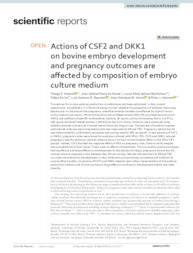Actions of CSF2 and DKK1 on bovine embryo development and pregnancy outcomes are affected by composition of embryo culture medium.
Actions of CSF2 and DKK1 on bovine embryo development and pregnancy outcomes are affected by composition of embryo culture medium.
Autoria: AMARAL, T. F.; GRAZIA, J. G. V. de; MARTINHAO, L A. G.; DE COL, F.; SIQUEIRA, L. G. B.; VIANA, J. H. M.; HANSEN, P. J.
Resumo: Procedures for in vitro embryo production in cattle have not been optimized. In the current experiment, we utilized a 3 × 3 factorial design to test whether the proportion of embryos becoming blastocysts in culture and the pregnancy rate after embryo transfer are afected by type of serum in the medium [no serum; 3% (v/v) KnockOut Serum Replacement (SR); 3% (v/v) fetal bovine serum (FBS)] and addition of specifc embryokines [vehicle; 10 ng/mL colony stimulating factor 2 (CSF2); 100 ng/mL dickkopf related protein 1 (DKK1)] at day 5 of culture. Embryos were produced using abattoir-derived ovaries and Y-sorted semen from two Angus sires. The percent of putative zygotes and cleaved embryos becoming blastocysts was improved by SR and FBS. Pregnancy rate at day 30 was determined for 1426 Nelore recipients and calving rate for 266 recipients. In the absence of CSF2 or DKK1, pregnancy rates were lower for embryos cultured with SR or FBS. CSF2 and DKK1 reduced pregnancy rate for embryos cultured without serum but had no detrimental efect in the SR or FBS groups. Indeed, CSF2 blocked the negative efect of FBS on pregnancy rate. Data on birth weights were available for 67 bull calves. There were no efects of treatment. The sire used to produce embryos had signifcant and large efects on development to the blastocyst stage, pregnancy rate at day 30, calving rate and pregnancy loss between day 30 and calving. Results indicate that (1) SR and FBS can improve embryonic development in vitro while also compromising competence of embryos to survive after transfer, (2) actions of CSF2 and DKK1 depend upon other characteristics of the embryo production system, and (3) sire can have a large efect on embryonic development before and after transfer.
Ano de publicação: 2022
Tipo de publicação: Artigo de periódico
Unidade: Embrapa Gado de Leite
Palavras-chave: Animal reproduction, Bovino, Embrião, Embryo (animal), Fertilização, In vitro fertilization, Produção in vitro, Reprodução Animal
Observações
1 - Por padrão são exibidas publicações dos últimos 20 anos. Para encontrar publicações mais antigas, configure o filtro ano de publicação, colocando o ano a partir do qual você deseja encontrar publicações. O filtro está na coluna da esquerda na busca acima.
2 - Para ler algumas publicações da Embrapa (apenas as que estão em formato ePub), é necessário ter, no celular ou computador, um desses softwares gratuitos. Sistemas Android: Google Play Livros; IOS: iBooks; Windows e Linux: software Calibre.
Acesse outras publicações
Acesse a Base de Dados da Pesquisa Agropecuária (BDPA) para consultar o acervo completo das bibliotecas da Embrapa.

